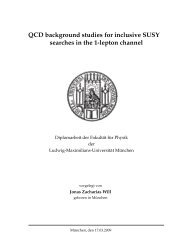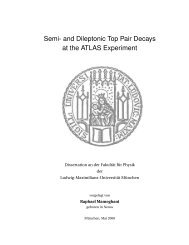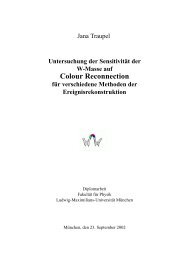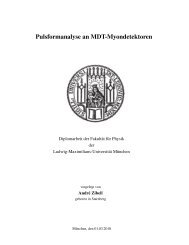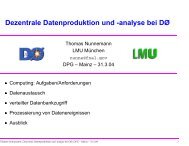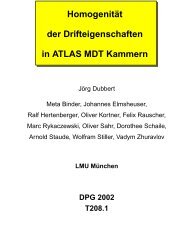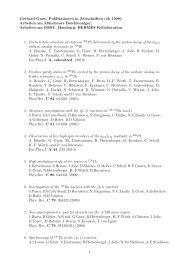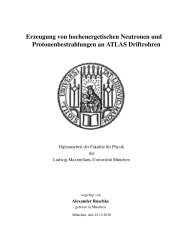development of micro-pattern gaseous detectors – gem - LMU
development of micro-pattern gaseous detectors – gem - LMU
development of micro-pattern gaseous detectors – gem - LMU
You also want an ePaper? Increase the reach of your titles
YUMPU automatically turns print PDFs into web optimized ePapers that Google loves.
Chapter 7<br />
Gas Gain Studies<br />
This chapter describes the gas gain <strong>of</strong> prototype 1.0 filled with a gas mixture <strong>of</strong> Ar/CO2 at the ratio<br />
93/7.<br />
7.1 Gain Studies for Ar/CO2 at 93/7<br />
The gas gain G is defined as the ratio <strong>of</strong> total created charge over primary charge in the detector.<br />
Due to recombination and electron transparency it is possible that not all liberated electrons in the<br />
triple GEM detector reach the anode. Furthermore, not all charges that reach the anode contribute<br />
to the recorded pulse due to voltage equalization on Cdet and Ccoup (see Ch. 3.4.3). Thus it is more<br />
reasonable to use the expression effective gas gain Ge f f [Bach 99]:<br />
G := Ntotal<br />
Nprimary<br />
= e αx<br />
chargelosses<br />
−→ Ge f f = Nsignal<br />
Nprimary<br />
where Nsignal corresponds to the fraction <strong>of</strong> created charge Qcoup reaching the coupling capacitor Ccoup<br />
<strong>of</strong> the preamplifier:<br />
Nsignal · e =: Qcoup<br />
with the elementary charge e = 1.6 × 10 −19 C. The gain depends on various parameters as the<br />
gas pressure and temperature, the gas itself and on the applied voltages as well as the geometry <strong>of</strong><br />
the GEM holes. As stated in Ch. 1.2.4 the gain is exponentially depending on the thickness <strong>of</strong> the<br />
amplification gap x in Eq 7.1. The first Townsend coefficient α is directly proportional to the applied<br />
fields [Leo 94]. To determine the effective gain we used the Kα line <strong>of</strong> the 55 Fe source. The amount<br />
<strong>of</strong> detected charges Nsignal is taken from the mean value <strong>of</strong> the Gaussian fit to the histogram (cf. Ch.<br />
4.1):<br />
Nsignal = Uout<br />
FCV · e = Kαmean · mADC<br />
FCV · e<br />
where FCV is the charge-to-voltage conversion factor, i.e. the internal amplification <strong>of</strong> the preamplifier<br />
and mADC the scaling factor <strong>of</strong> the flash ADC, 0.244 mV per ADC channel. The estimated error<br />
∆Nsignal corresponds to the standard deviation σ <strong>of</strong> the fitted Kα peak in the same way.<br />
Data were taken with a centrally placed irradiation source and readout via the Canberra2004 preamplifier<br />
with the tabulated conversion factor FCV = 1 V/pC. The temperature and pressure were held<br />
constant at T = 296 ± 1 K and p = 1020 ± 10 mbar, respectively. It can be seen that the effective<br />
73<br />
(7.1)<br />
(7.2)<br />
(7.3)



